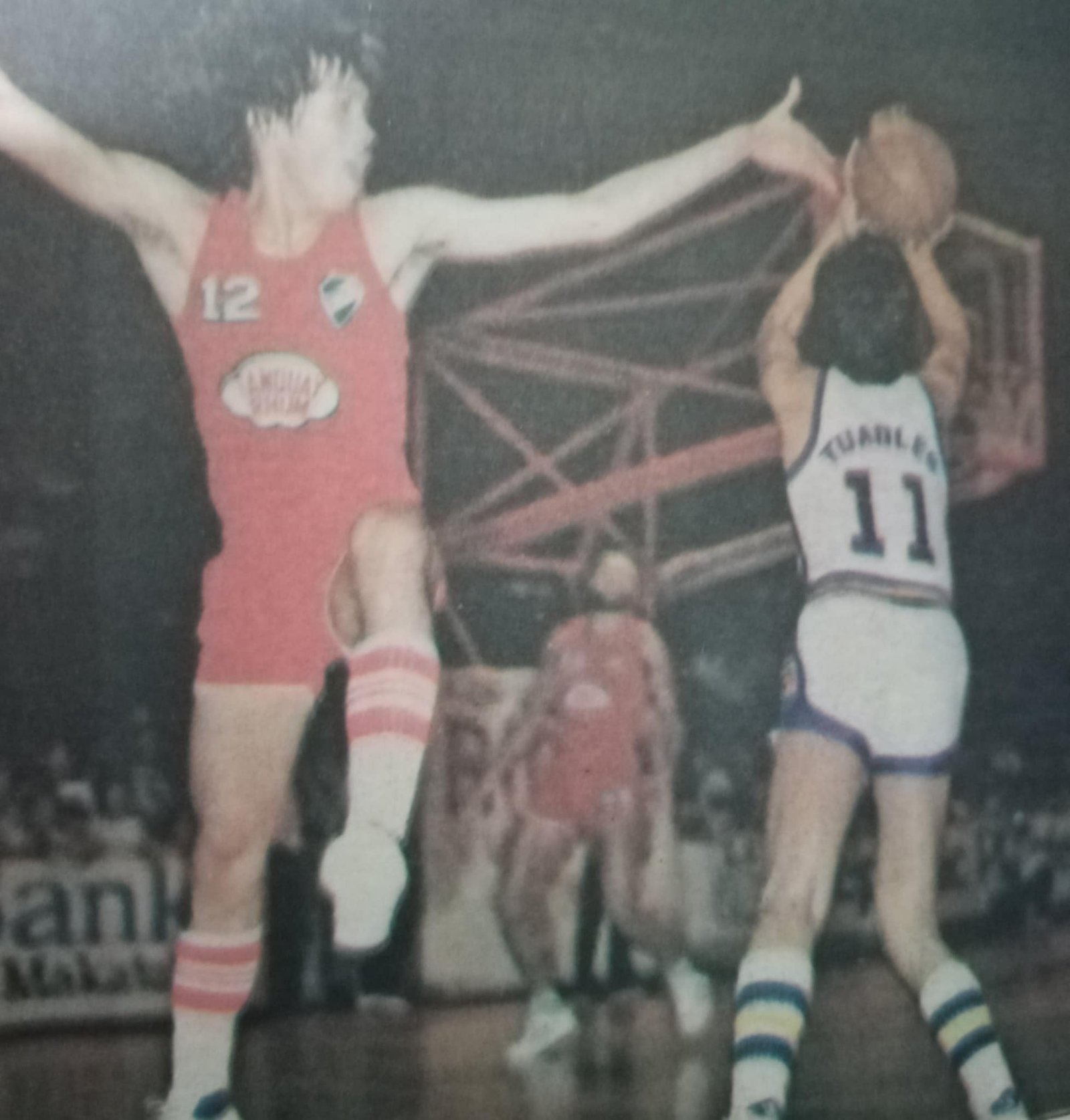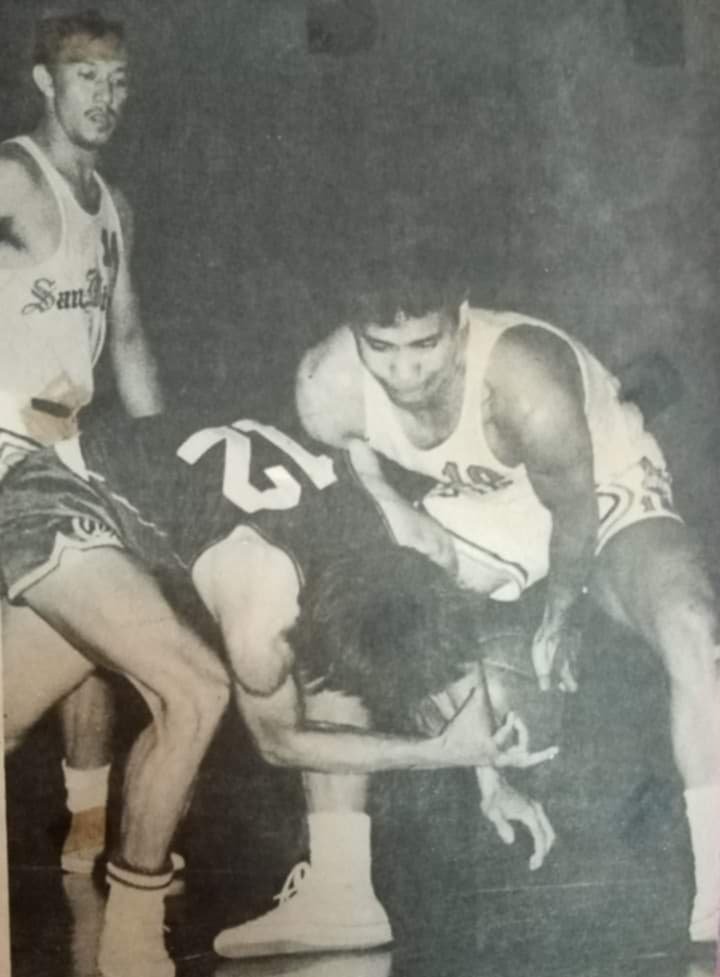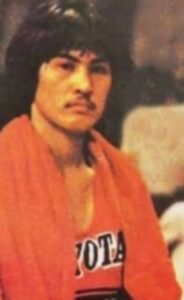
by Henry L. Liao
In 1974, from February 18 to 25, the National Inter-Collegiate and Inter-Secondary competitions were held in Cebu City—the hotbed of Philippine basketball.
At the time, numerous prominent Cebuano and Visayan athletes were already making a name for themselves in the Manila Industrial and Commercial Athletic Association (MICAA), the precursor of Asia’s first professional league, the Philippine Basketball Association (PBA).

Among the top players in the Manila hoop circuit were Joaquin “Jake” Rojas Jr., Manny Paner, Ramon Fernandez (from Maasin, Leyte), Alberto “Abet” Guidaben (from the Camiguin Islands), Francis Arnaiz (from Bacolod City), Rosalio “Yoyong” Martirez, Alejandrito “Dodie” Estrada, Ernesto “Estoy” Estrada, Lawrence Mumar (born in Cebu City), Jesse Sullano, Jaime Noblezada (from Iloilo City), Maximino Baguio, Wilfredo Velasco, Hubert Pilipinas, Danilo Basilan, Mariano Figuracion, Alfredo “Fred” Enriquez, Zito Bacon, and Eusebio “Boy” Adolfo, among others.
Most of these players had suited up in Cebu’s premier collegiate league, which would later evolve into the Cebu Schools Athletic Foundation, Inc. (CESAFI). Some—such as Fernandez, Paner, Martirez, Mumar, Rojas, and Arnaiz—also earned spots on the national team.

At the youth level, standout names included Arnulfo “Arnie” Tuadles and Oscar Rocha.
That year, the University of the Visayas (UV) dominated both divisions of the tournament. The Baby Green Lancers clinched the Inter-Secondary crown with a 73–60 victory over the San Beda Red Cubs. The Mapua Tech Red Robins took third place with a nail-biting 77–76 win over Southwestern University (SWU), another Cebuano school.
The Baby Lancers roster featured Vicente Dalaguit, Fortunato Manulat Jr., Reynaldo Ibanez, Marlon Sarabosing, Jose Kangleon, Cicero Samson, Antonio Diaz, Efren Allison, Eduard Flores, Sancho Dagohoy Jr., Teody Pastrano, and a future PBA household name—Arnulfo “Arnie” Tuadles.
After starring for UV in college, the 6-foot-3 Tuadles played for the Manilabank Golden Bankers and the San Miguel Braves in the MICAA before turning pro. In 1979, he was named PBA Rookie of the Year with the Toyota Tamaraws and earned a spot on the Mythical Five.
Hailing from Argao, Cebu, Tuadles enjoyed a 14-season PBA career (1979–1992) with multiple teams. In 2025, he was belatedly honored as one of the 50 Greatest Players in PBA history—joining the 10 additional names added to the original list of 25 from the year 2000.

Tragically, Tuadles passed away on November 2, 1996, at the age of 40, due to a shooting incident.
Notable players on the San Beda Red Cubs included Joaquin “Chito” Loyzaga and Raymundo Barriero.
Meanwhile, the UV Green Lancers captured the collegiate title with an 82–72 victory over the De La Salle Green Archers in the finals. Along the way, UV also routed another Manila powerhouse—Far Eastern University (FEU)—by a score of 87–68. That FEU squad included Roberto de la Rosa, Nicanor Bulaong Jr., Gregorio Gozum, Jacinto “Jack” Chua, Pablo Javier, and Herminio Adriano. All except Adriano would go on to play in the PBA.
The UV Green Lancers’ championship lineup featured Yusuf Taupan, Delfin Pepito, Hermes Sumalinog, Genaro Villanueva, Mitchell Duran, Paulino Velasco, Ricardo Rita, Nicolas Seno, Marlowe Jacutin, Oscar Rocha, and Melecio Seno. Velasco, Jacutin, and Rocha later advanced to the MICAA and eventually the PBA.
De La Salle, which defeated Southwestern University 71–64 but fell to Colegio de San Jose-Recoletos 63–58 earlier in the tournament, was composed of nearly the same core that would win the NCAA title in November of that year.
The Inter-Collegiate squad was led by prolific scorer Lim Eng Beng, with strong support from Edward Dizon Jr., Virgil Villavicencio, Dennis Mendoza, Peter Ley, Alfredo Arrieta, Amadeo Sagarbarria, Gregorio Rastrullo Jr., William “Billy” Johnston, Desiderio Delfin Jr., Lope Leonio, Roland Raymundo, Jacob Uchico, Alejandro Buendia, and Lupo Gosiengfiao.

After the graduation of Delfin, Raymundo, Uchico, Buendia, and Gosiengfiao, newcomers Henry Brodett, Elmo Tong, Raymond Uy, Antonio Bangoy Jr., and Alfredo Perlas joined Coach Valentin “Tito” Eduque’s 1974 NCAA team. That squad won 15 of its 16 games behind league top scorer Lim Eng Beng and claimed De La Salle’s second NCAA championship in four years.
To this day, the University of the Visayas holds the record for the most CESAFI college division championships, with 15 titles. In the high school division, Sacred Heart School–Ateneo de Cebu and UV are tied with seven championships each.
- Northport draft pick joins long list of Tiong Lian alumni in PBA - September 11, 2025
- PBA@50 - September 10, 2025
- Of Luka, and FIBA EuroBasket - August 2, 2025

![Kai Sotto [FIBA.com photo]](https://sportsbytes.com.ph/wp-content/uploads/2021/01/4622.jpg)
![PH National Team that won the bronze in 1954 World Basketball in Rio de Janeiro. [Henry Liao photo]](https://sportsbytes.com.ph/wp-content/uploads/2021/01/144429345_221818172990075_1891445414791191084_n.jpg)
![The 1954 Nationals that won the bronze medal in the 1954 World tournament. [Henry Liao photo]](https://sportsbytes.com.ph/wp-content/uploads/2021/02/144950691_774393143285027_3026363166572188338_n.jpg)